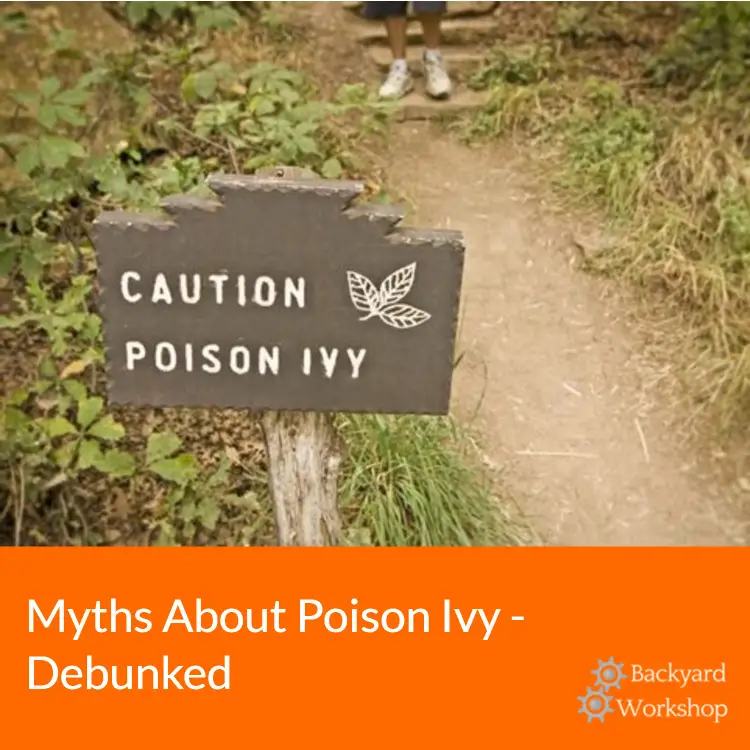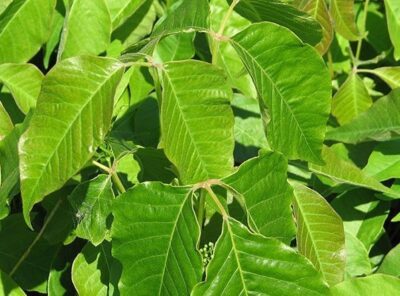12 Myths About Poison Ivy – Debunked

With warmer weather right around the corner, It’s time to be on the lookout for poison ivy, which is one of the most troublesome spring plants. Many of us have vivid memories of suffering from its effects and have scoured the United States to find the most prevalent myths and legends regarding the rash-inducing plant. Here are 12 myths about poison ivy – debunked.
1. It’s Safe to Use a String Trimmer To Kill Poison Ivy
Using a string trimmer or lawn mower to kill poison ivy is one of the more prevalent myths that we encountered about getting rid of a patch of the plant.
Let’s be clear – it is NOT safe to use a weed wacker or battery powered string trimmer to kill poison ivy.
Poison ivy and other related plants contain a toxic compound called urushiol oil that is quickly absorbed in human skin and causes an allergic rash for most people. The oil gets dispersed when the string trimmer disturbs the leaves and stem. When inhaled, urushiol can cause an allergic reaction in the nose and along the nasal passages leading to the lungs.
2. When the Plant Dies, It Can No Longer Cause a Rash and Is Safe to Touch
This myth has caused considerable head-scratching for those who are true believers. The oily toxin urushiol is to blame for the continued durability of the reaction after the plant dies. The death of the plant will prevent it from producing more urushiol, but the toxin that the plant produced before its demise will still be present and active.
If you are disposing of dead plants around the yard – including poison ivy – it is wise to cover all exposed skin – particularly the hands, arms, and legs – to reduce the chance of accidental exposure.
3. Scratching The Blisters Will Spread a Rash
As stated earlier, the cause of a poison ivy rash is the urushiol compound, so unless the mixture is on the hands, scratching the blisters will not cause the rash to spread. However, excessive scratching is never a good idea and can lead to infection or permanent scarring of delicate skin tissue.
4. The Leaves Are the Only Poisonous Part of the Plant
The poison ivy plant itself is not toxic, but it produces a toxic compound. This compound is found throughout the plant, from the leaves to the root. Contact with any part of the plant is capable of causing an allergic response.
5. Chewing Poison Ivy Leaves Will Provide Immunity
Of the many myths on this list, this is one of the riskiest. Chewing the leaves of poison ivy, oak, or a sumac plant will NOT provide immunity to a reaction and can be pretty dangerous.
Urushiol is harmful to humans, but many animals in the wild routinely eat this plant without suffering ill effects. If you or someone you know has eaten any of these plants, please get to an emergency room as soon as possible.
6. The Blisters Are Capable of Spreading the Disease
Much like scratching, contact with blisters themselves cannot spread the disease from person to person. Be sure to keep the area clean and dry to aid in healing and reduce the chances of a skin infection caused by scratching. If itching is excessive, calamine lotion can help soothe irritated skin.
7. Gasoline Will Stop the Rash From Spreading
Exposure to large amounts of gasoline can be fatal. Gasoline is a caustic substance to the skin, causing peeling, cracking, and burning. Furthermore, gasoline will not affect the poison ivy rash in any way except to make the area more uncomfortable.
Much like rubbing alcohol, gasoline is an organic solvent and may help dissolve urushiol from the skin but will not affect the spread of the blisters.
8. Sensitivity to Toxicodendron Plants Never Changes
While some people are more sensitive to Toxicodendron plants than others, these levels can change over a lifetime. Just because a person did not respond to contact with poison ivy as a child does not mean that the body will respond the same way as an adult.
9. You Can’t Develop Blisters From Touching Contaminated Clothing
Urushiol oil is very durable and, if left undisturbed, can remain active and capable of causing a skin reaction for years. To remove the oil, you must thoroughly wash contaminated clothing or boots with soap and hot water.
10. Pets Can’t Spread Poison Ivy, Oak, or Sumac
As stated earlier, humans’ reactions to poison ivy, oak, and similar plants are unique to our species. Many other animals come in contact with the plants – even consuming them in some cases – with no effects on their well-being. While pets cannot develop the same sensitivity to urushiol, they can spread the oil to humans on their fur.
11. The Poison Ivy Rash Must Be Tightly Covered at All Times
Like most skin irritations, the inflammation caused by poison ivy responds well to ventilation. Oxygen is a crucial ingredient to speed up the skin’s healing process. Wrapping the irritated area can disturb the delicate blisters, which should be left to heal on their own since they protect the raw wound underneath.
12. Taking a Bath Shortly After Exposure Will Help Contain the Rash
While instinct may be to take a nice, hot bath right after known poison ivy exposure, this may do more harm than good. The soapy bathwater may remove the urushiol oil from one area of the body. However, as you sit in the tub, the water may spread to another place.
Taking a hot, soapy shower is a better option. The shower will remove any oil remaining on the skin and wash it down the drain.
Conclusion
While the rash caused by the body’s reaction to poison ivy can become itchy and uncomfortable, the symptoms can usually be managed at home and do not require a trip to the doctor. However, in some people, a reaction to urushiol can be life-threatening.
If you have difficulty breathing or swallowing or develop swelling of the eyes or tongue after exposure to poison ivy, this is a medical emergency; please get treatment immediately. If the ash does not improve after a few days, please see your doctor. We hope debunking some of these common poison ivy myths will help to keep you safe if you ever come in contact with the plant in the future.




![Best Corded Electric Weed Eater / Wacker Reviews - The Ultimate Guide For [FYear]](https://www.backyardworkshop.com/wp-content/uploads/./corded-electric-string-trimmer-400x296.jpg)
